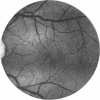Abstract
True vitelliform dystrophy rarely appears in the adult population. We describe 10 cases in adults of bilateral vitelliform lesions clinically mistaken for Best's disease. Fluorescein angiography is a useful tool in distinguishing this dystrophy from Best's disease or other diseases. The angiographic findings suggest pigment epithelial disease. Adult vitelliform degeneration may lead to dry atrophic macular degeneration in a similar fashion as macular drusen. Symptoms and visual findings in these patients are fairly stable, and may be only slowly progressive in spite of ophthalmoscopic and fluorescein angiographic changes over a period of years. The electro-oculogram is useful in separating adult vitelliform macular degeneration from true vitelliform dystrophy.
Full text
PDF







Images in this article
Selected References
These references are in PubMed. This may not be the complete list of references from this article.
- BRALEY A. E., SPIVEY B. E. HEREDITARY VITELLINE MACULAR DEGENERATION. A CLINICAL AND FUNCTIONAL EVALUATION OF A NEW PEDIGREE WITH VARIABLE EXPRESSIVITY AND DOMINANT INHERITANCE. Arch Ophthalmol. 1964 Dec;72:743–762. doi: 10.1001/archopht.1964.00970020743003. [DOI] [PubMed] [Google Scholar]
- Curry H. F., Jr, Moorman L. T. Fluorescein photography of vitelliform macular degeneration. Arch Ophthalmol. 1968 Jun;79(6):705–709. doi: 10.1001/archopht.1968.03850040707008. [DOI] [PubMed] [Google Scholar]
- Deutman A. F. Electro-oculography in families with vitelliform dystrophy of the fovea. Detection of the carrier state. Arch Ophthalmol. 1969 Mar;81(3):305–316. doi: 10.1001/archopht.1969.00990010307001. [DOI] [PubMed] [Google Scholar]
- Fishman G. A., Trimble S., Rabb M. F., Fishman M. Pseudovitelliform macular degeneration. Arch Ophthalmol. 1977 Jan;95(1):73–76. doi: 10.1001/archopht.1977.04450010073006. [DOI] [PubMed] [Google Scholar]
- Gass J. D. A clinicopathologic study of a peculiar foveomacular dystrophy. Trans Am Ophthalmol Soc. 1974;72:139–156. [PMC free article] [PubMed] [Google Scholar]
- Kingham J. D., Lochen G. P. Vitelliform macular degeneration. Am J Ophthalmol. 1977 Oct;84(4):526–531. doi: 10.1016/0002-9394(77)90446-9. [DOI] [PubMed] [Google Scholar]
- Krill A. E., Morse P. A., Potts A. M., Klien B. A. Hereditary vitelliruptive macular degeneration. Am J Ophthalmol. 1966 Jun;61(6):1405–1415. doi: 10.1016/0002-9394(66)90478-8. [DOI] [PubMed] [Google Scholar]
- Krill A. E. The electroretinographic and electrooculographic findings in patients with macular lesions. Trans Am Acad Ophthalmol Otolaryngol. 1966 Nov-Dec;70(6):1063–1083. [PubMed] [Google Scholar]
- Morse P. H., MacLean A. L. Fluorescein fundus studies in hereditary vitelliruptive macular degeneration. Am J Ophthalmol. 1968 Sep;66(3):485–494. doi: 10.1016/0002-9394(68)91534-1. [DOI] [PubMed] [Google Scholar]
- SORSBY A., SAVORY M., DAVEY J. B., FRASER R. J. L. Macular cysts; a dominantly inherited affection with a progressive course. Br J Ophthalmol. 1956 Mar;40(3):144–158. doi: 10.1136/bjo.40.3.144. [DOI] [PMC free article] [PubMed] [Google Scholar]














